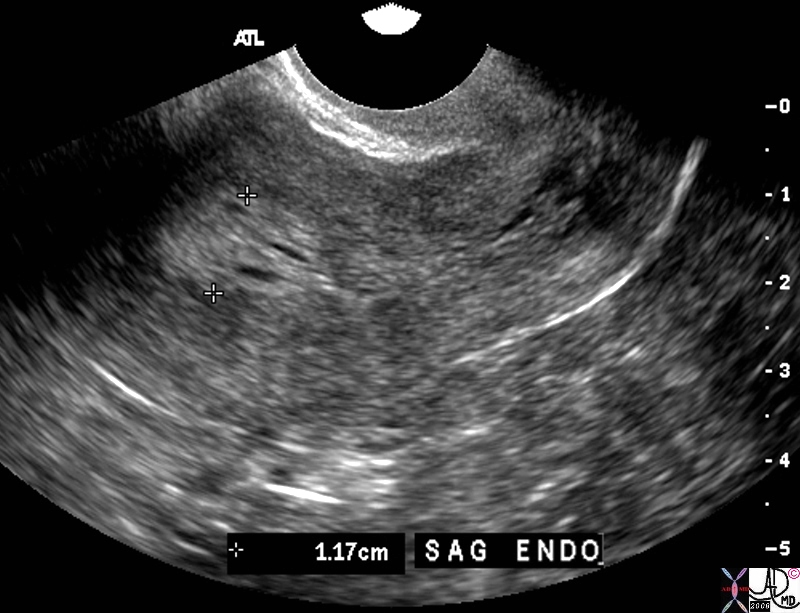Definition
Endometrial carcinoma is a malignant disease of the inner lining of the uterus usually occurring in postmenopausal women.
Most endometrial cancers are caused by excess exposure to estrogen without the opposing influence of progesterone. However, the cause for some endometrial cancers is multifactorial or unknown.
The result is uncontrolled growth of the endometrium.
The structural changes are characterized by proliferation of glands within the endometrium. These glands are filled with tightly packed malignant cells. The functional changes are characterized by growth of the endometrium after menopause, a time when the endometrium usually atrophies since estrogen levels decrease.
When endometrial carcinoma occurs in a premenopausal woman, the functional change is characterized by endometrial growth not regulated by the menstrual cycle.
In both cases, the result is a clinical presentation of abnormal bleeding. This bleeding can be at an abnormal time, for example after menopause or not during menses, or in an abnormally increased amount.
Imaging is useful in the initial evaluation of a patient with abnormal vaginal bleeding by pelvic ultrasound and sonohysterography.
Diagnosis is made by endometrial biopsy and staging is based on findings at lymph node dissection during surgery.
Treatment of endometrial carcinoma is surgical, with total hysterectomy as well as removal of both ovaries and fallopian tubes. As stated above, the pelvic lymph nodes are also removed for staging. Radiation therapy is used for patients who are not candidates for surgery, as well as after surgery for patients with advanced disease. Hormone therapy with progesterone and chemotherapy are used for patients with disease recurrence. Most endometrial carcinomas present with bleeding early in disease progression. As a result, with early treatment, patients often have a good prognosis.
|
Thick Heterogeneous Endometrium |
|
The transvaginal ultrasound is from a 60 year old female who presents with spotting Ultrasound reveals a heterogeneous endometrial stripe consistent with endometrial hyperplasia though endometrial carcinoma is a possibility. Malignant neoplasia is a a les likely possibility Courtesy Ashley DAvidoff MD copyright 2010 83301.81s |
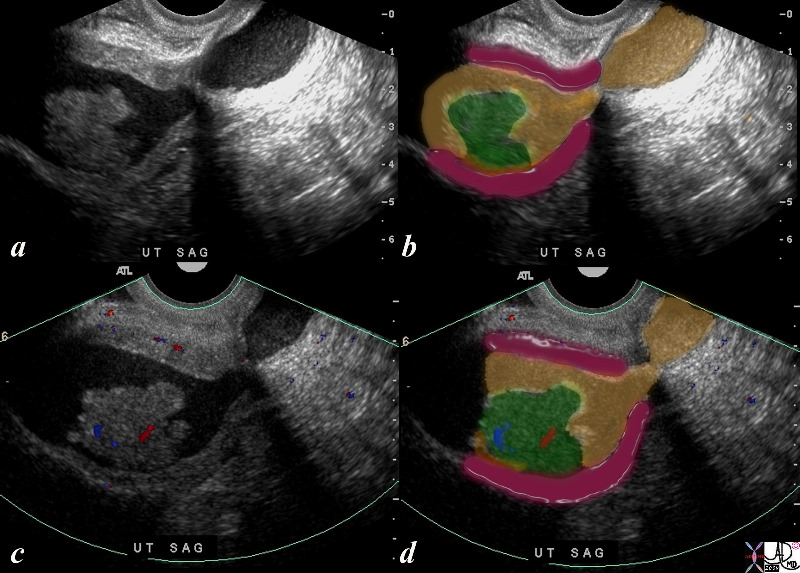
Endometrial Carcinoma and Uterine Obstruction |
|
The ultrasound is from a 70 year old post menopausal female who presents with an enlarged uterus. The endometrial stripe is enlarged and is filled with fluid and an enhancing soft tissue mass consistent with an endometrial carcinoma. Note blood flow as depicted by Doppler exam (c) characterizing the soft tissue as tumor rather than a clot. Courtesy Ashley Davidoff MD copyright 2009 all rights reserved 86206c.8s |
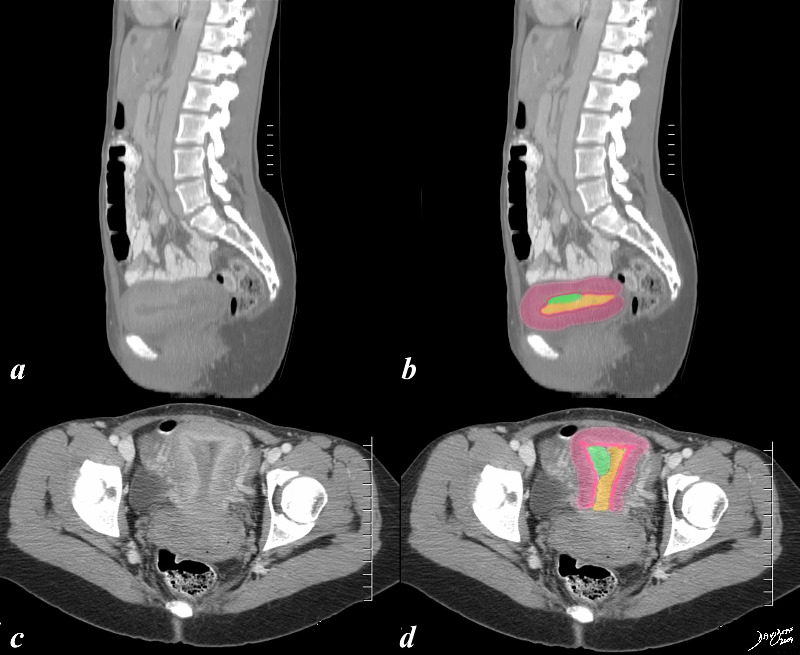
Focal Endometrial Thickening |
|
The coroanal CTreformatted CTscan images are from a 46 year old female with endometrial carcinoma. The images show an focal area of soft tissue thickening (green), on the superior surface (b) and rightward (green d) of the endometrial cavity (orange) . 83494c01.8s Courtesy Ashley Davidoff Copyright 2010 all rights reserved |
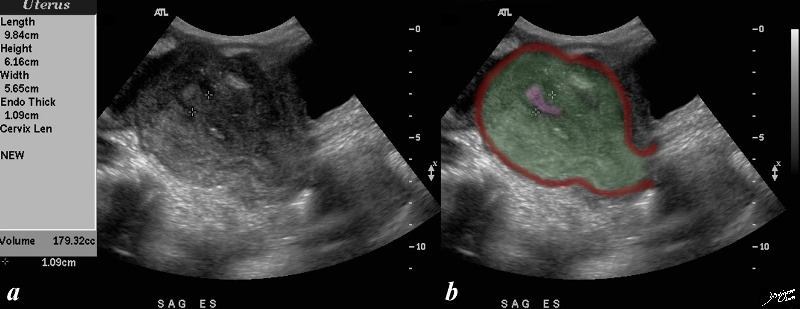
Endometrial Cavity Expanded with Tumor |
|
The ultrasound of a 58 year female with expanded endometrial cavity is shown. The cavity is filled with heterogenous material (green) representing a combination of tumor, fluid necrotic material and blood. Pathology showed adenocarcinoma, endometriod type, grade I/III with tumor necrosis. In this iamge a small portion of normal appearing endometrium is shown in pink. Tumor involvement with the right ureter and secondary hydronephrosis of the right kidney is present. Courtesy Ashley Davidoff Copyright 2009 all rights reserved 83510c03.8s |
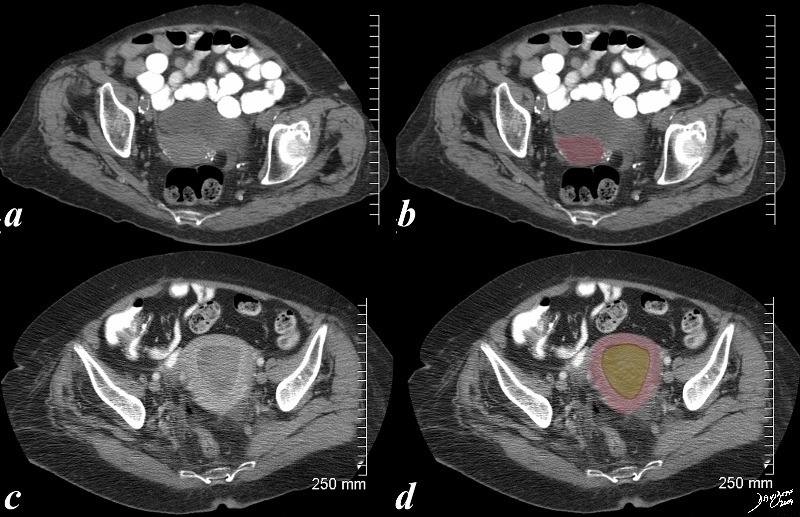
Assessing the Large Uterus in the Elderly |
|
The first CTscan (a,b) is from an 86 year old patient with a small but normal post menopausal uterus showing characteristic vascular calcification. The second CT (c,d) is from an 83F year old patient with distended endometrial cavity (orange in d) with known uterine carcinoma Courtesy Ashley Davidoff MD copyright 2009 all rights reserved 83731c01.8S |
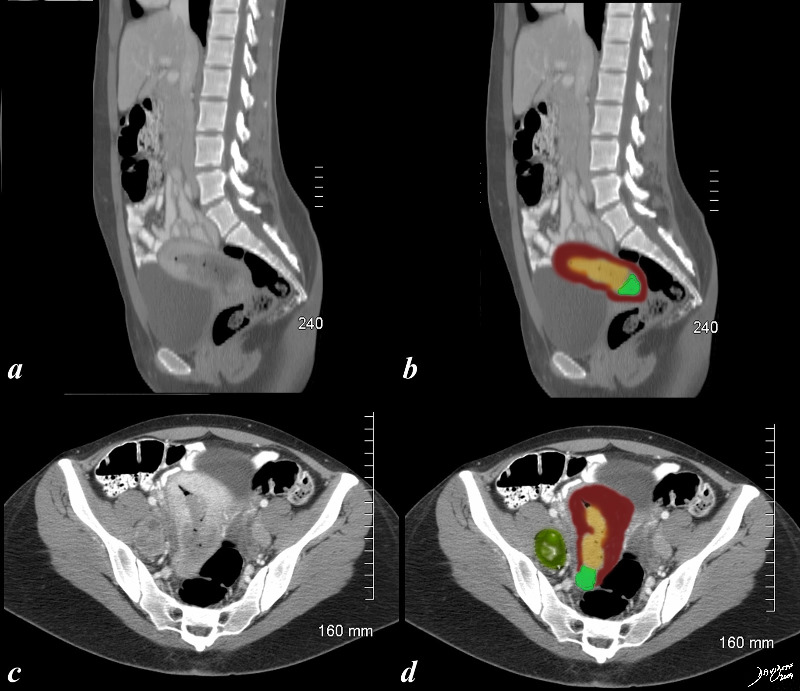
Endometrial Carcinoma |
|
The axial CTscan is from a 31 year old female with carcinoma. The images show an expanded irregular endometrial cavity (yellow) that contains air (black), soft tissue (green), and fluid (yellow), uterus with an enhancing filling defect (green overlay in b). The mass could arise from the cervix based on its position or from the uterus. The former is more likely based on the patients age.. A solid appearing mass is seen in the right adnexa (dark green) representing either a solid mass in the ovary or a enlarged iliac node. These findings are consistent cervical carcinoma or less likely endometrial with secondary obstruction and pyometria. 83484c02.8s Courtesy Ashley Davidoff Copyright 2010 all rights reserved air in endometrial cavity infection |
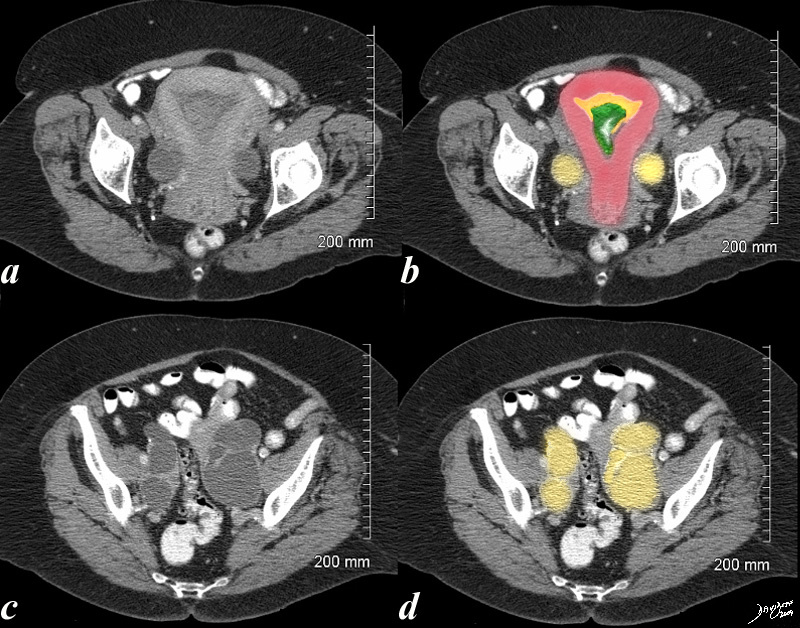
Endometrial Carcinoma with Hydrosalpinx |
|
This 70 year old female presents with pelvic discomfort. The CT shows an endometrium (orange in b) filled with complex soft tissue in the endometrial cavity (green in b) and the Fallopian tubes are distended with fluid (yellow in b and d) caused by the obstructing carcinoma. The uterus is enlarged Courtesy Ashley Davidoff MD copyright 2009 all rights reserved 48414c02.8s |
Metastases
Regional Nodes
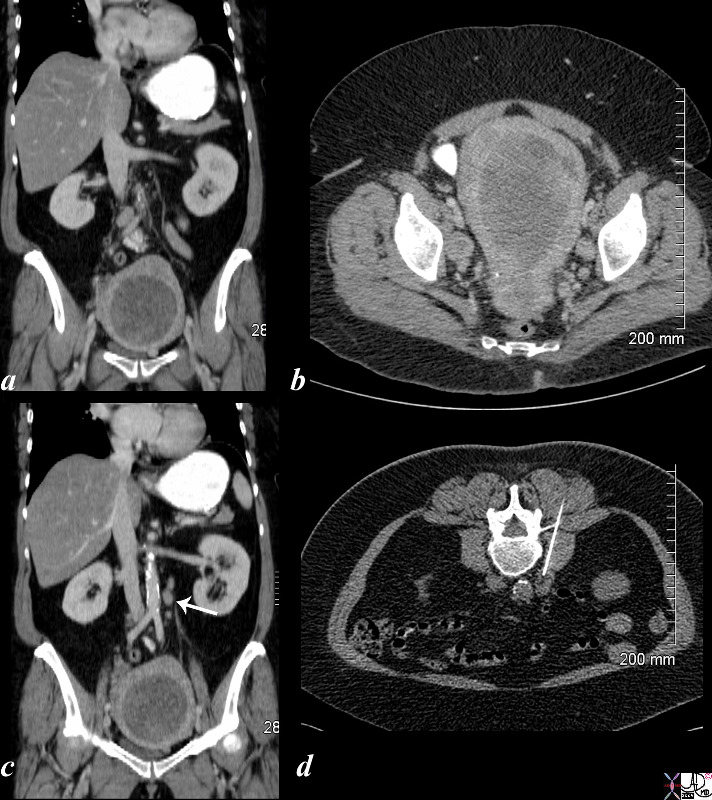
Regional Nodes |
|
61 year old female with enlarged endometrial cavity and cervical mass consistent with cervical carcinoma complicared by obstruction of the endometrial cavity. The cavity is filled with complex material probably from a combination of secretions, fluid, blood and tumor. Lymph nodes in the left paraaortic area (c, white arrow) were biopsied under CT guidance (d) and were positive for cervical cancer. Courtesy Ashley DAvidoff copyright 2009 all rights reserved 85306c01.8s |
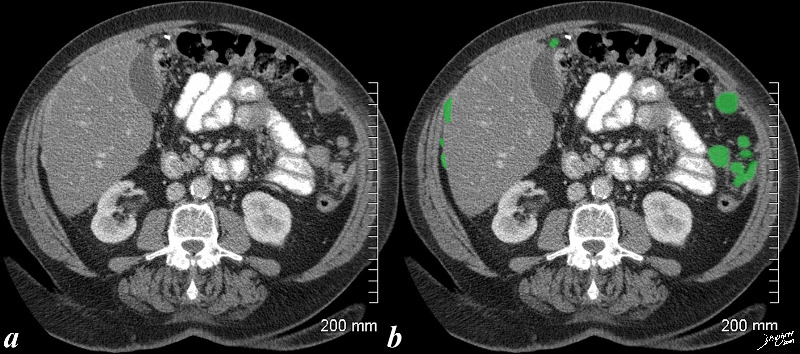
Peritoneal Metastases |
|
79 year female with transperitoneal metastasis from endometrial carcinoma overlaid in green. Fatty liver is present. Courtesy Ashley Davidoff Copyright 2009 all rights reserved 83526c.8s |
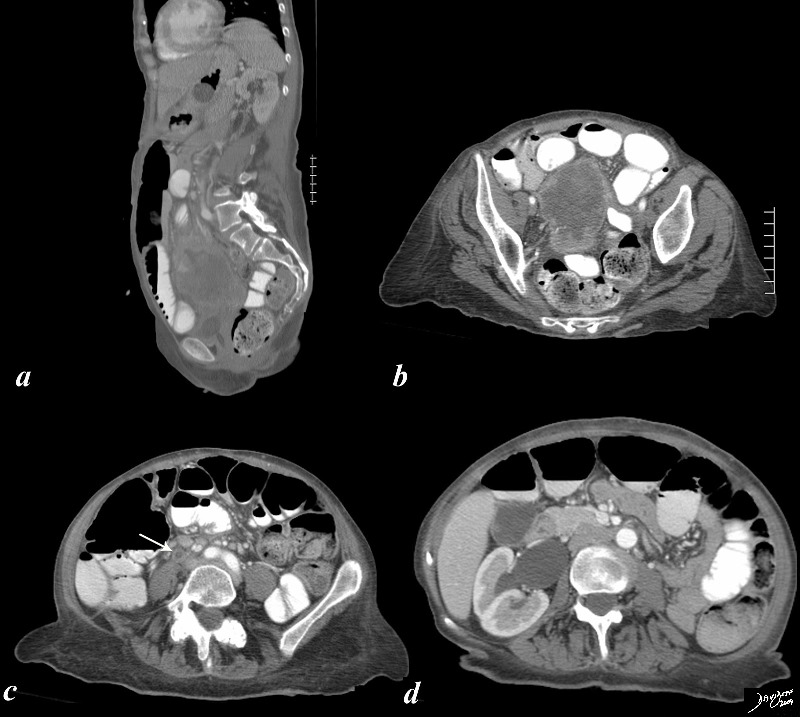
Metastasis to the Right Ureter Causing Hydronephrosis |
|
The CTscan of a 58 year female with expanded endometrial cavity is shown. (a,b) The cavity is filled with heterogenous material (green) representing a combination of tumor, fluid necrotic material and blood. Pathology showed adenocarcinoma, endometriod type, grade I/III with tumor necrosis. Tumor involvement of the right ureter (arrow in c) and secondary hydronephrosis of the right kidney is present. (d) Courtesy Ashley Davidoff Copyright 2009 all rights reserved 83510c07.8s |

